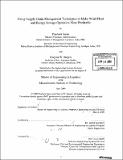Using supply chain management techniques to make wind plant and energy storage operation more profitable
Author(s)
Saran, Prashant; Siegert, Clayton W
DownloadFull printable version (47.94Mb)
Other Contributors
Massachusetts Institute of Technology. Engineering Systems Division.
Advisor
Jarrod Goentzel.
Terms of use
Metadata
Show full item recordAbstract
Our research demonstrates that supply chain management techniques can improve the incremental gross profits of wind plant and storage operations by up to five times. Using Monte-Carlo simulation we create and test scenarios that achieve incremental operating profits of up to 15 percent of base case revenue, and show pre-tax profit. We show that energy storage-specifically in the form of utility-scale batteries - can become economically-viable today when using supply chain management strategies under certain scenarios. To achieve these results we have built a simulation model with three data inputs. First, we synthesized the output of a 120 MW wind plant in Maine for both summer and winter seasons. Second, we simulated New England ISO market pricing data for both the Day-Ahead and Real-Time markets in summer and winter seasons using Monte Carlo simulations. Third, using actual data from two existing battery companies, we incorporated the technical and cost specifications for two energy storage facilities. All of these data inputs feature adjustable parameters so we can test various plant configurations, market volatilities and storage capabilities, among other inputs. Using our model, we then employed supply chain management network design strategies and daily operating policies to test profitability improvements on our wind plant-plus-storage operation. For example, we ran simulations for scenarios where our storage facility is either located in Maine next to our wind plant, or located in another state. (cont.) Also, since storage can make wind generation a predictable capacity resource, we ran simulations to test results in both the Day-Ahead and Real-Time markets. In addition we developed four (4) inventory management policies with dynamic input (charge) and output (discharge) strategies for our storage units. For each policy, we had to conceptualize the policy - while considering planning horizon, lead time, holding costs, shortage costs, market pricing and storage capabilities - and then build functionality in our model to execute those strategies in dynamic pricing and wind plant output environments. The outcomes of our simulation model include incremental gross profit, operating profit and pre-tax profit for each of 54 scenarios, as well as 11 management insights for wind plant and storage operators, storage technology manufacturers and New England ISO leadership.
Description
Thesis (M. Eng. in Logistics)--Massachusetts Institute of Technology, Engineering Systems Division, 2009. Includes bibliographical references (leaves 161-164).
Date issued
2009Department
Massachusetts Institute of Technology. Engineering Systems DivisionPublisher
Massachusetts Institute of Technology
Keywords
Engineering Systems Division.